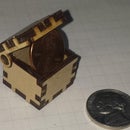Introduction: Epoxy Holding Tool
For a while, I used wood glue to hold my wooden projects together. While wood glue worked, I found myself dissatisfied with the cure time, the short term strength, and the color of the final product. I also tried CA glue, but even the gel seemed to soak into the wood rather than bond the edges together.
So, I started using 5 minute (clear) epoxy.
Epoxy has been dependable, consistent, and the two components of the epoxy have remained viable even after a year of storage in the Arizona heat.
My epoxy of choice has been Bob Smith Industries P/N BSI-201H, (4.5 ounce /128 gram combined), available in Hobby stores and on Amazon.
Supplies
Laser powerful enough to cut through 1/8 inch Baltic Birch plywood
12 inch x 12 inch piece of 1/8 Inch Baltic Birch
5 minute (clear) epoxy
1/8 inch bamboo Bar-B-Que skewer
Step 1: Epoxy Storage While in Use / Not in Use
Problem:
When the bottles are less than full, and I flip them over to dispense the liquid inside, it takes a while for the viscous fluid to travel down to the inverted tip. Then, when I'm done, the bottle gets set on its side or on the base and the fluid drains to the bottom again.
Solution:
Leave the bottles inverted (and capped) so the liquids are always down at the tip ready to use.
OK . . . . But . . . New problems.
1) I didn’t have a consistently convenient place to keep the bottles inverted when using them.
2) The bottles were always falling over and rolling around.
3) One time I left the bottles inverted for several days and a leaky cap left epoxy resin all over my work surface.
Step 2: Purpose Made Storage for Bob Smith Epoxy Containers
Solution:
Make a caddy to hold the bottles in the 'tips-down' position when in use and in the 'tips-up' position when not in use.
When the Epoxy is stored, the tips are upright (no mess).
When I’m using the Epoxy, the cover is opened all the way and caddy is flipped over. The lid then acts as a stand to cradle the bottles with the tips down.
While using the epoxy, between applications, I have a place to put the bottle that holds it 'tips-down'.
If the bottles leak while 'tips-down', they leak into an enclosed space.
If the bottles leak and damage the caddy, its cheap and easy to replace.
When I’m done, I close the box, flip it over so I can read the words ‘Epoxy Caddy’, and it holds the bottles upright (tips-up).
Step 3: Caddy Can Be Cut From Single 12" X 12" Piece of 1/8 Inch Baltic Birch.
Not everyone has access to Corel Draw (my software of choice). However, all drawing programs that I know of will import either an SVG file, a DXF file or a PDF file. So, along with the Corel Draw file, I have added those. After the file is imported, group everything together and make the outside rectangle dimensions for the panel 10.000” wide by 11.000 inches tall. This should make everything inside the panel the right size.
The words ‘Epoxy Caddy’ and the 3x3 square underneath are all meant to be vector etched (Low power / high speed). All the other lines are cut lines (High power / low speed).
After the panel has been cut out, the pieces on the inside of the panel are held in place by 0.020” gaps in the vector lines that act as connecting tabs.
Leave the pieces attached to the panel for sanding and paint. Later, the pieces can (easily) be poked out and assembled. The nubs left over by the broken tabs can be sanded as well.
Notes:
- It has been my experience that it is good practice to dry fit all the pieces before assembly using glue. Make sure the parts are located correctly and fit . . . first.
Step 4: Assemble the Lid and the Box and Insert the Bamboo Hinge Pin.
- The top has two similarly sized pieces. One has a larger center tab. Careful.
- I use epoxy, but wood glue will work. I’ve tried GEL CA Glue without much luck. If it works for you, go for it.
Assemble the pieces as shown in the pictures.
Last and final is the hinge pin. After everything is assembled and before the glue has set hard slide the lid over the box and line up the hinge pin holes. Insert the hinge pin and apply glue to the OUTSIDE ends on both sides to hold the pin in place.
For storage, the box is closed and sits as shown
Step 5: Epoxy Tips and Tricks
I Needed:
- A disposable mixing pallet
- I use 3 x 3 Post-it notes to mix on. They are cheap, stick to most surfaces, hold their place while mixing and lift off easily.
- A disposable mixing stick
- I use round toothpicks. They hold up better than Flat toothpicks. I not only use the toothpicks for mixing, but I also use them for precision glue application.
- To add color to the Epoxy
- I found that a small (actually, a VERY small) dab of acrylic paint is more than sufficient to provide an opaque color tint to the mixture. And does not noticeably effect epoxy set time or adhesion.
- Something to clean up wet epoxy residue
- I keep a quart bottle of alcohol and paper towels around for cleaning epoxy that has not set yet. After the Epoxy sets, you will need an abrasive.

Participated in the
Build a Tool Contest












